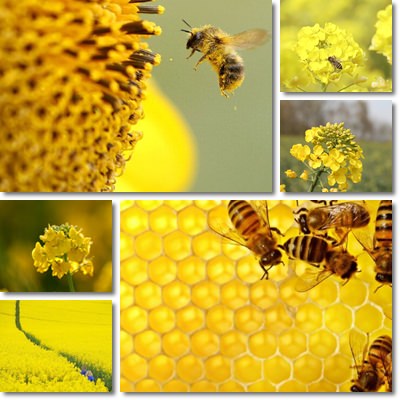Rapeseed honey is a special variety of monofloral honey made from the flower nectar and pollen of rapeseed (Brassica napus). This particular variety has a few unique characteristics, such as a fast crystallization time and a sweet-peppery flavor. It’s most renowned for its ulcer-treating properties, but has other therapeutic effects as well such as antibacterial and antioxidant effects, mild immunostimulating properties, a tonic action as well as other digestive benefits. In order to enjoy its beneficial action, the honey has to be raw and unprocessed.
What is rapeseed? Rapeseed is a crop grown primarily for oil production and is related to mustard and cabbage, from where it draws some of its more unusual properties. The plant is also called canola and the resulting oil canola oil (or rapeseed oil). The oil obtained from the seeds of the plant is a rich source of Omega-9 fatty acids in the form of erucic acid. This form however has been shown to be harmful for the heart muscle, hence the reason why edible rapeseed oil is bound to have less than 5% erucic acid. The plant species is also a wonderful source of flower nectar, allowing for the production of an interesting and aromatic honey variety.

What is rapeseed honey? Rapeseed is a monofloral (unifloral) honey, meaning it is produced mostly from the nectar and, incidentally, pollen of rapeseed flowers, but may contain limited amounts of other sources of nectar and pollen as well (clover, for example). The beautiful, vivid yellow flowers are the source of a peppery-tasting honey with a surprisingly fast crystallization time. Because rapeseed flowers also contain pollen which is more or less incidentally added to honey, the resulting honey can cause allergic reactions in individuals already allergic to rapeseed pollen. If you are allergic to honey bees (the enzymes they secrete to make honey, their sting), then you are most likely allergic to everything they produce, from honey to propolis, royal jelly, bee bread, beeswax etc.
What does rapeseed honey look like? The variety has an interesting appearance: while the flowers serving as a source of nectar are a beautiful, vivid yellow, the resulting honey has a very light and dull beige-yellow pigment. The color can be described as a whitish yellow or a milky yellow. Since the honey can crystallize even before being harvested, it is not liquid, but soft-solid in texture. Its consistency is given by the fine crystals it forms. Typically, rapeseed honey crystallizes in 3 to 4 weeks.
What does rapeseed honey smell and taste like? The smell of the honey is reminiscent of that of rapeseed flowers, somewhat oily, subtly heavy like a vegetal oil, but faintly floral nonetheless. The honey has a medium taste intensity, with a moderately-low sweetness, but nevertheless sugary (due to its texture) and with an original flavor profile. Perceived flavor notes may include: faint cabbage notes, slight mustard or peppery aftertaste, but pleasant tasting. If processed to be made liquid, soft-creamy or to alter its taste, it may not retain its original taste, color or therapeutic properties. Also, the honey can ferment over time and in improper storage conditions, potentially becoming sour.
Good to know. Not all rapeseed planted for oil or honey production is organic. Much of the crops throughout North America are genetically modified to resist various pests or pesticides and have currently been introduced to Europe too. So check the origin and label of your honey to see if it’s organic or from genetically modified crops.

What is rapeseed honey good for? The variety is said to boast numerous therapeutic uses, from offering digestive relief to promoting nervous system relaxation and improving various symptoms of upper respiratory tract infections in particular. Here are 6 wonderful proposed health benefits of rapeseed honey:
1) Natural remedy for gastritis and stomach ulcer. Rapeseed honey has been traditionally recommended for the management and treatment of both gastritis and stomach ulcers. Both the antibacterial and anti-inflammatory elements in the honey and its consistency are believed to encourage the healing of the stomach lining and soothe irritation, hence the supposed effectiveness. The natural sugars in the honey boast mild prebiotic properties, helping feed the good bacteria in our intestines, contributing to an overall better digestion. Other honey varieties like acacia, manuka or forest honeys are eaten raw on an empty stomach in the morning for digestive relief as well.
2) Antibacterial and anti-inflammatory action. Rapeseed honey is known to possess mild natural antibacterial and anti-inflammatory properties. Its action is primarily local, hence the reason why it can help in the treatment of upper respiratory tract infections like colds or flu and help improve their symptoms. Studies show a preparation of rapeseed honey with a 40% concentration can efficiently inhibit the growth of antibiotic-resistant Staphylococcus aureus, while royal jelly together with rapeseed honey are even more efficient (Reduction Effect of Royal Jelly and Rape Honey Alone and in Combination Against Methicillin-Resistant Staphylococcus aureus Strains). The pollen in rapeseed honey also has mild immuno-modulating effects, stimulating the immune system response.
3) Calms cough and soothes a sore throat. Eating raw rapeseed honey can help reduce sore throat discomfort and possibly calm cough due to the honey’s natural antibacterial and soothing properties. It is recommended to avoid eating and drinking anything for about an hour after taking honey to allow it to exert its action.
4) Source of vitamins and minerals. Research shows that although rapeseed honey has a lower nutrient content than other honeys, it does contain a wide variety of essential nutrients, particularly dietary minerals such as potassium, phosphorus, calcium and magnesium as well as smaller amounts of zinc and sodium (Determination of trace elements in rape honey and its corresponding rape flower and stem). Heating the honey can cause the nutrients in it to deteriorate, especially vitamin C.
5) Natural tonic action. Like all honey types, rapeseed too is energizing and great for preventing low blood sugar levels (hypoglycemia) and fatigue. In addition to natural sugars, the variety contains small amounts of all sorts of nutrients, from vitamins and dietary minerals to pollen particles, antioxidant compounds and other elements, all of which contribute to its tonic effect.
6) Good for uneven skin and acne. Light-colored honeys can be used as a natural face mask for uneven skin tone. Rapeseed is an especially good natural exfoliating agent due to its consistency and can help unclog pores, reduce sebum and clean the face of impurities, potentially helping reduce acne breakouts (if used consistently). The variety may hold other skin benefits as well, such as calm irritation or make skin brighter, more radiant.
Other supposed health benefits. Rapeseed honey is said to exert a hepatoprotective action, helping maintain liver health and, indirectly, detoxify the body of toxins. It is also believed to possess mild sedative, relaxing or sleep-encouraging properties by regulating the activity of certain neurotransmitters in the brain. Certain enzymes in the honey are believed to be good for bone health and osteoporosis. However, such benefits have yet to be confirmed.
Conclusion
Rapeseed honey is an original-tasting variety, suited to many uses. Its most prized therapeutic properties include a natural antibacterial and anti-inflammatory action, cough relief, eliminating sore throat discomfort, tonic properties as well as gastritis and stomach ulcer management. But irrespective of the individual action of the honey, for it to have any therapeutic effect or preserve its unique taste profile, it has to be raw, unheated and unprocessed in any way.
